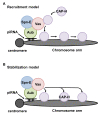Non-coding RNAs enter mitosis: functions, conservation and implications
- PMID: 21356070
- PMCID: PMC3055801
- DOI: 10.1186/1747-1028-6-6
Non-coding RNAs enter mitosis: functions, conservation and implications
Abstract
Nuage (or commonly known as chromatoid body in mammals) is a conserved germline-specific organelle that has been linked to the Piwi-interacting RNA (piRNA) pathway. piRNAs are a class of gonadal-specific RNAs that are ~23-29 nucleotides in length and protect genome stability by repressing the expression of deleterious retrotransposons. More recent studies in Drosophila have implicated the piRNA pathway in other functions including canalization of embryonic development, regulation of maternal gene expression and telomere protection. We have recently shown that Vasa (known as Mouse Vasa Homolog in mouse), a nuage component, plays a mitotic role in promoting chromosome condensation and segregation by facilitating robust chromosomal localization of condensin I in the Drosophila germline. Vasa functions together with Aubergine (a PIWI family protein) and Spindle-E/mouse TDRD-9, two other nuage components that are involved in the piRNA pathway, therefore providing a link between the piRNA pathway and mitotic chromosome condensation. Here, we propose and discuss possible models for the role of Vasa and the piRNA pathway during mitosis. We also highlight relevant studies implicating mitotic roles for RNAs and/or nuage in other model systems and their implications for cancer development.
Figures


Similar articles
-
A role for vasa in regulating mitotic chromosome condensation in Drosophila.Curr Biol. 2011 Jan 11;21(1):39-44. doi: 10.1016/j.cub.2010.11.051. Epub 2010 Dec 23. Curr Biol. 2011. PMID: 21185189
-
Tejas functions as a core component in nuage assembly and precursor processing in Drosophila piRNA biogenesis.J Cell Biol. 2023 Oct 2;222(10):e202303125. doi: 10.1083/jcb.202303125. Epub 2023 Aug 9. J Cell Biol. 2023. PMID: 37555815 Free PMC article.
-
Gender-Specific Hierarchy in Nuage Localization of PIWI-Interacting RNA Factors in Drosophila.Front Genet. 2011 Aug 30;2:55. doi: 10.3389/fgene.2011.00055. eCollection 2011. Front Genet. 2011. PMID: 22303351 Free PMC article.
-
piRNA pathway and the potential processing site, the nuage, in the Drosophila germline.Dev Growth Differ. 2012 Jan;54(1):66-77. doi: 10.1111/j.1440-169x.2011.01316.x. Dev Growth Differ. 2012. PMID: 23741748 Review.
-
Assembly and Function of Gonad-Specific Non-Membranous Organelles in Drosophila piRNA Biogenesis.Noncoding RNA. 2019 Nov 6;5(4):52. doi: 10.3390/ncrna5040052. Noncoding RNA. 2019. PMID: 31698692 Free PMC article. Review.
Cited by
-
RNA granules in germ cells.Cold Spring Harb Perspect Biol. 2011 Dec 1;3(12):a002774. doi: 10.1101/cshperspect.a002774. Cold Spring Harb Perspect Biol. 2011. PMID: 21768607 Free PMC article. Review.
-
The multiple hats of Vasa: its functions in the germline and in cell cycle progression.Mol Reprod Dev. 2011 Oct-Nov;78(10-11):861-7. doi: 10.1002/mrd.21363. Epub 2011 Aug 5. Mol Reprod Dev. 2011. PMID: 21823188 Free PMC article. Review.
-
PIWI interacting RNAs perspectives: a new avenues in future cancer investigations.Bioengineered. 2021 Dec;12(2):10401-10419. doi: 10.1080/21655979.2021.1997078. Bioengineered. 2021. PMID: 34723746 Free PMC article. Review.
-
DEAD-box RNA helicase Belle/DDX3 and the RNA interference pathway promote mitotic chromosome segregation.Proc Natl Acad Sci U S A. 2011 Jul 19;108(29):12007-12. doi: 10.1073/pnas.1106245108. Epub 2011 Jul 5. Proc Natl Acad Sci U S A. 2011. PMID: 21730191 Free PMC article.
-
Glycerol-3-phosphate acyltranferase-2 behaves as a cancer testis gene and promotes growth and tumorigenicity of the breast cancer MDA-MB-231 cell line.PLoS One. 2014 Jun 26;9(6):e100896. doi: 10.1371/journal.pone.0100896. eCollection 2014. PLoS One. 2014. PMID: 24967918 Free PMC article.
References
Publication types
LinkOut - more resources
Full Text Sources
Molecular Biology Databases

